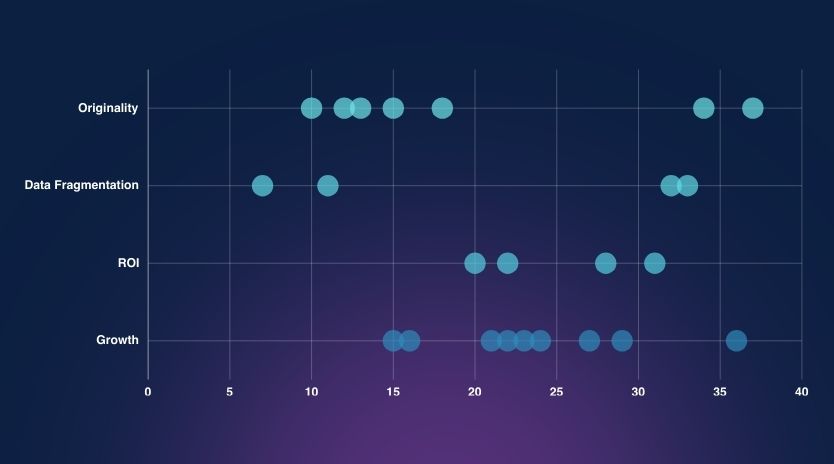4 AI challenges in marketing and how to solve them

Artificial intelligence is reshaping digital marketing for private schools and businesses at an unprecedented pace. According to a recent IBM report, business leaders plan to increase their use of AI by 82% by 2025. With this rise comes a wealth of opportunities, but also a growing list of challenges that marketers must navigate. While AI promises efficiency, personalization, and innovation, the reality isn’t always so simple. For many marketers, integrating AI into workflows has raised tough questions about data quality, brand authenticity, effectiveness, and innovation. Below, we break down four of the most pressing AI challenges in marketing and how to solve them.
1. Data fragmentation limits AI’s power
The truth is that AI systems are only as good as the data they’re fed. When customer information is scattered across disconnected platforms, it results in fragmented insights and weak personalization. Fragmented insights mean that AI tools are making decisions based on incomplete or inconsistent data, which can result in irrelevant recommendations, missed opportunities, and a poor user experience.
The solution:
- Audit your data: Regularly check for accuracy, consistency, and completeness.
- Unify data sources: Tools like Customer Data Platforms (CDPs) help bring data together for a complete customer view.
- Leverage real-time processing: Improve campaign relevance by reacting to user behavior as it happens.
- Establish governance: Define clear rules for data ownership, access, and compliance.
Without clean, centralized data, even the most advanced AI tools will fall short of their promise. Building a strong data foundation is the first step to meaningful AI success.
2. Your content still sounds robotic
AI has made content production faster, but often at the cost of originality. In fact, according to a 2023 study by Orbit Media, only 29% of marketers said AI-generated content was as effective as content written by humans. Overreliance on generic AI outputs can make your brand voice feel flat or impersonal, especially if you’re not adding human insight, tone, or storytelling to the mix.
This causes many brands to end up sounding the same, publishing bland, generic content that fades into the noise. This disconnect occurs when AI is expected to create brand-specific messaging without being given the right context.
The solution:
- Document your brand voice: Clearly outline tone, vocabulary, and values in a brand style guide. Use this guide to train AI tools or fine-tune prompt instructions.
- Stop settling for first drafts: Treat AI-generated content as a rough starting point. Add nuance, brand personality, and real insights before publishing.
- Use smarter prompts: Avoid broad instructions. Instead, give specific context about your audience, goals, and previous content for more tailored results.
AI should enhance creativity, not replace it. When used thoughtfully, it can amplify your unique voice rather than dilute it.
3. Measuring ROI feels like a guessing game
One of the biggest limitations in AI adoption in digital marketing for private schools and businesses is proving its value. Many marketers find it difficult to connect AI tools with clear performance metrics like conversions or revenue, which can hinder buy-in and future investment. This is so because AI-driven campaigns often involve multiple touchpoints and complex customer journeys, making it challenging to attribute specific outcomes directly to AI efforts without robust tracking and analytics systems in place.
The solution:
- Set measurable KPIs: Define specific performance indicators that show whether your AI efforts are working.
- Use A/B testing: Compare AI-driven strategies to traditional ones to isolate impact.
- Implement attribution models: Understand AI’s contribution across the entire buyer journey.
- Visualize with dashboards: Real-time analytics help track and communicate performance clearly.
4. AI isn’t generating real growth
Many teams fall into the trap of using AI solely to repurpose existing content or automate repetitive tasks. While this improves efficiency, it doesn’t drive innovation or expand your market reach. When AI is limited to being a productivity tool, its potential to generate real business growth is left untapped. The true value lies in using AI to analyze audience behavior, uncover untapped customer segments, spot emerging trends, and personalize strategies in ways that were previously impossible. Without this shift in mindset, brands risk staying stagnant, efficient, but not evolving.
The solution:
- Shift the role of AI from creator to investigator: Ask deeper prompts like “What unmet needs exist in marketing for private schools?” or “How are competitors framing social media?”
- Feed AI real data: Use inputs from your CRM, customer feedback, or top-performing content to surface hidden patterns and growth opportunities.
- Use AI early in the process: Involve AI during brainstorming and planning, not just execution, to shape strategy from the start.
When treated as a thinking partner rather than a content machine, AI can help uncover untapped opportunities and competitive advantages. For instance, a Latin food restaurant could use AI to identify a rising interest in regional dishes like arepas in specific neighborhoods, insights that could shape menus, promotions, or even expansion plans.
As we continue to witness how AI in marketing holds incredible potential, it’s important to be aware of the challenges and tackle them. The path to effective AI adoption in digital marketing for private schools and businesses is paved with intentional practices. By addressing these four common challenges, marketers and brands can move beyond AI hype and start seeing real business impact.


